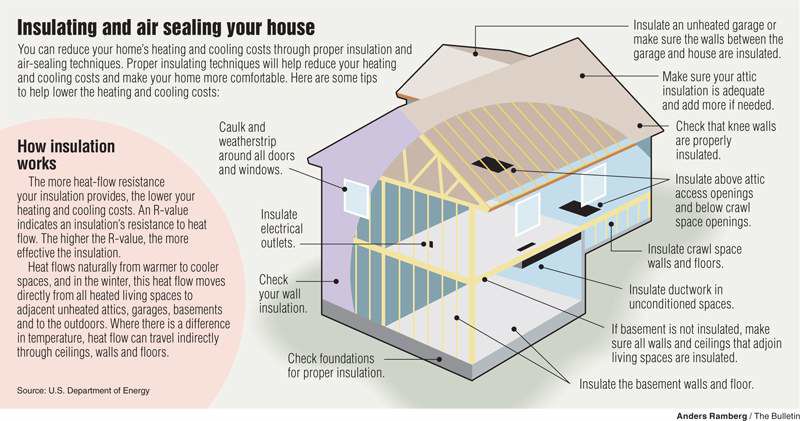Seal leaks to keep winter heating indoors
Published 5:00 am Tuesday, October 21, 2008

- Seal leaks to keep winter heating indoors
Leaves have already started falling, and it’s time for people to start getting winter sweaters out of summer storage. But homeowners might also want to think about “putting a sweater on their house,” said Lizzie Rubado, a project manager with Oregon’s Energy Trust.
It’s a good time to insulate houses, seal up cracks and tune up heating systems, she said — and there are organizations and programs that can help people out.
“This is the best time to make these improvements,” Rubado said. “Yes, seasonally, it’s the best time, but energy costs are going up, and there’s all this support financially to do this.”
Customers of Pacific Power, Portland General Electric, Cascade Natural Gas or NW Natural can contact the Energy Trust, an organization funded by a surcharge on some utility bills that focuses on energy efficiency and renewable energy.
Free energy audits
Through the Energy Trust, they can set up a free energy audit, she said. A specialist will come to the customer’s home and calculate how efficiently it uses energy by checking out insulation levels, air leaks, thermostats, water heaters, lighting and other energy-related features.
“They’re going to provide you with a customized action plan that lays out everything — things you can do right now or long term,” she said. And the energy auditor will also be able to tell homeowners what cash incentives or credits they might be eligible for.
The Energy Trust, for example, offers inducements for projects like optimizing heat pumps, which comes with a $150 incentive, or testing and sealing heat ducts, which has a $300 incentive attached. Floor insulation comes with a 45 cents per square foot benefit.
The organization, funded by a surcharge on some power and gas utility bills, also has bonuses, she said, like if a natural gas customer does two projects at a time, they could get a $100 bonus — or $200 if they do three projects at once. The organization sends the money once the work is done, she added.
“There’s a lot of funding there to help make this investment more affordable,” Rubado said.
And then there are state tax credits for a number of projects.
“These provide a credit on your Oregon income taxes for making your home more efficient in a number of ways,” she said.
Oregon also operates a program that provides incentives to people who heat their homes with wood pellets, heating oil, propane, kerosene or butane called the State Home Oil Weatherization program, said Dave Brook, and energy analyst with the Oregon Department of Energy. That program offers rebates of up to $500 for energy-saving improvements, and lists how to apply for one on the state’s Web site.
Homeowners can call their utility company to learn what options are available, said Colleen Neel, energy and weatherization programs manager with NeighborImpact, a Bend nonprofit. That organization also provides help to low-income residents, including weatherizing services and assistance in paying heating bills.
Inexpensive options
But there are also some simple, and cheap, ways people can keep their houses toasty, including using foam sealant and silicone caulking to seal up leaks where cold air sneaks in.
“It’s not very glamorous, but it really helps cut down on drafts,” Neel said.
There are lots of inexpensive options for keeping hot air inside the house, Brook said.
“In older homes, 20 to 30 percent of the heat may be lost through air leakage,” he said. “If cold air is coming into the house, around the foundation and the floor, it means that warm air is escaping somewhere else.”
The first place to look for escaping warm air is the attic, he said. If homeowners can see through the attic floor, Brook recommended filling the cracks with the expanding foam insulation available at hardware stores. It’s not good for around chimneys because of the heat, he added, but the foam insulation is also good for cracks in the basement and around the foundation.
Weatherstripping is good for older windows, he said, and there are also plastic insulation kits, and for about $5 apiece, people can seal off windows.
“Keep the air you paid money to heat up inside the house,” Brook said.
And also make sure that your heating system is working properly, he added — people should get tune-ups of their gas or oil heat system or heat pump every three to five years, he said, and check the filters every year.
Ron Young, owner of Young’s Insulation, said he usually sends people to the Energy Trust so they can figure out what programs can help them.
“When they see how much money they can save, and how long it can take to recoup an estimated cost, now they have something they can get a hold of,” Young said. His company does a lot of attic insulation, he said, as well as installing batting material under floors.
He also recommends even doing small things like checking electric outlets or light switches, since sometimes that’s an area where cold air leaks in.
“It won’t be noticeable perhaps in the utility bill itself,” he said. “However every little bit helps.”
For information
For more information on the Energy Trust’s programs, visit www.energytrust.org.
To learn more about Oregon’s residential energy tax credits, visit www.oregon.gov/ENERGY/CONS/RES/RETC.shtml, and to check out the State Home Oil Weatherization program, go to www.oregon.gov/ENERGY/CONS/RES/weather/weahome .shtml.
For more information about NeighborImpact’s weatherization program, call 541-548-2380, ext. 138, and for more information about low-income energy assistance, call 541-504-2155.






